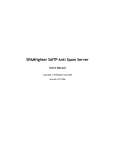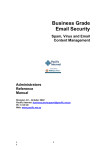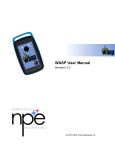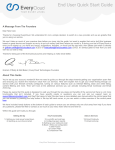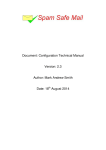Download User guide
Transcript
Vodafone Hosted Services Getting your email User guide Welcome. This guide will show you how to get your email, now that it is hosted by Vodafone Hosted Services. Once you’ve set it up, you will be able to pick up and send email through online webmail, or your desktop mail application. And if you’re signed up as a Professional user, you will also be able to access email from your mobile, and share your calendar, address book, task manager and documents. This guide assumes that you are already set up as a user through Vodafone Hosted Services by your email administrator, and that they have given you a username and password. webmail 2 address book 7 calendar 8 professional users 9 documents 10 briefcase 11 desktop mail 12 mobile email 16 dealing with spam email 18 Vodafone Hosted Services – webmail Webmail Being able to access your email online using webmail means that you can pick up your mail regardless of your location, as long as you have an internet connection. Open the webmail main page • open your browser on your PC or Mac, and go to https://webmail.vhsmail.vodafone.com • save this page as a bookmark, so that you can get to it quickly in the future • log in using your username and password • if your browser supports it, save the login details (don’t do this if you’re using an unsecure computer, such as one in an internet café). The webmail portal is where all your email folders can be found. You will also be able to see tabs for Address Book, Calendar, Documents and Briefcase. 1 When you first login you’ll be asked if you want to view emails using AJAX or HTML. Using AJAX provides a much richer experience than HTML, and because it stays connected with the server your email updates will appear without needing to refresh the page. However, this also uses up more bandwidth, and some features may not be supported by your browser. If you want to keep your data use under control, or are using an older browser, select the HTML option. You can change this at any time by clicking on the Preferences tab. 2 Vodafone Hosted Services – webmail view your mail The Mail tab is where you view, create and manage your email. It works in very much the same way as a desktop email program, so once you have selected a message (or messages) you can use the blue buttons to: • delete it1 • move it to another folder • print it • reply to it • forward it • label it as junk • tag it Clicking on the name of the sender will show their email address. Syncing your email Because your email is kept in sync, any changes you make to your email in the Webmail portal will also be made when you view your desktop and mobile mail. If you delete an email, it will not be lost – you can find deleted emails in the Trash folder. 1 If you delete the emails in the Trash folder then you won’t be able to restore them. 3 Vodafone Hosted Services – webmail write a new email To write a new email, just click on the New Mail blue button. • enter the email address to send it to. If it’s in your address book it will autocomplete. • before you add another address, put a semi-colon ; after the first address • use the blue buttons to add attachments, spell check or save it as a draft • then click on the Send blue button to send it. 4 Vodafone Hosted Services – webmail webmail folders In the folders column you can view your Inbox, sent mail, drafts and other email collections. You can make new folders to hold emails related to specific projects or people: • click on the New Folder blue button • enter the name of the new folder • move related emails into that folder using the Move blue button. The Folders column can also contain other collections, such as Tags (which will show you emails that have been tagged). 5 Vodafone Hosted Services – webmail webmail search You can search through your email folders just as you can in your desktop email. Simple searches can be carried out by entering a word, name or email address into the Search field. This will look through all your email messages looking for that content. More advanced searches can be carried out by specifying a search operator – this is a special keyword followed by a colon, e.g. ‘in:inbox’ returns messages which are in the inbox folder, whereas ‘from:someone’ returns messages which have the word “someone” in their email address. If multiple search terms are entered, separated by spaces, they are combined together by default, e.g. ‘in:inbox house’ returns messages which are in the inbox and which have the word ‘house’ in them. If you delete an email, it will not be lost – you can find deleted emails in the Trash folder. Click on the Preferences tab to change the Search settings to include the Trash folder. 6 Vodafone Hosted Services – webmail address book Click on the Address Book tab to open your address book. This address book is synchronised with your desktop and mobile Mail programs, so be careful not to delete contacts you may need in other situations. You can enter a name in the top right Search bar to find a contact or email correspondent, or just click on the folder you want to view in the Address Books column. Add a new contact • to enter a new contact, click on the [New] blue button, and add the details. Emailed contacts • this shows the email addresses of the people who have emailed you. 7 Vodafone Hosted Services – webmail calendar Click on the Calendar tab to open your calendar. This calendar will be synchronised with your desktop and some mobile Mail programs, so any entries you make will appear there as well. Calendar views • click the Day, Work Week, Week, Month, or Schedule (appointment list) blue buttons to change the way you view your calendar entries • click on the Today button to be taken to today’s appointments, no matter which view you’re in. New entry • click on the New blue button to choose a type of new entry, and enter the details • you can set alarms, repeats and other options. New calendar • to set up a new calendar – such as one for personal appointments – click on the New Calendar blue button. 8 Vodafone Hosted Services – webmail professional professional users If your email administrator has signed up to the Professional Email service, you may be able to see tabs for Documents and Briefcase, as well as Address Book and Calendar. • if your email administrator has signed up for the Professional Email service, they may still have given you only Basic privileges. Please check with them if you want to find out if you can access the Professional features. 9 Vodafone Hosted Services – webmail professional documents Clicking on the Documents tab lets you create simple documents that will synchronise with your desktop email program. The Documents application is a document sharing and collaboration application that gives you a central place to develop and organise information. Images, spreadsheets, and other rich web content objects that can be embedded into Document pages. External documents can also be uploaded. The pages display in your browser. Documents is made up of notebooks with individual pages that are organized in a table of contents. By default, every account includes one notebook. You can create as many additional notebooks as you need. 10 Vodafone Hosted Services – webmail professional briefcase Clicking on the Briefcase tab lets you copy files from your computer to your account. You can access these files whenever you log into your account from any computer and you can share these files with other colleagues. Like your own personal hard drive, Briefcase is a complete solution for storing, sharing and managing your important files in one place. Upload a file • click on the Upload File blue button, then select the file you want to upload • if it is a folder, it will automatically be zipped (compressed into one file, that can be uncompressed when downloaded). View a file • select the file you want to view, and then click on the View blue button and choose how you want to view it. 11 Vodafone Hosted Services – desktop mail desktop mail You can also send and receive your emails from your usual PC or Mac mail program. What is the difference between POP3 and IMAP? Setting this up may be slightly more complicated than for the webmail, but we will go through the process for the main email programs you’re likely to have (Microsoft® Outlook Express®, Microsoft Outlook 2007®, and Mac OS X Mail). If you need help, then please contact the person who sets up your company email. Everyone using your account has a mailbox which can receive and store mail. Employees in your company or members of your family can have separate mailboxes. Once set up, you can just use it like any other email account. You can connect to your mailbox using POP3 or IMAP: • POP3 – downloads and stores your messages on your computer • IMAP – stores your mail folders (inbox, sent items, etc) on the server and this means you can view them from any location (home, office, etc). Webmail uses IMAP to connect to the mailbox. If your email client connects using POP3, you can still use webmail to view new messages in the inbox (you won’t be able to see the messages in any other folders which are stored on your computer). However, you will only be able to view the messages whilst your normal email client is off and not downloading mail. 12 Vodafone Hosted Services – desktop mail set up Outlook Express If you or your users are running Microsoft® Outlook Express®, you can set it up using the following steps: Using IMAP 1 start up Outlook Express. This can be found in your computer’s “Start” menu. 2 from the menu, click “Tools”, then “Accounts” 6 type the email address you are configuring (e.g. me@mydomain. co.uk) then click the “Next” button 7 your incoming mail server type is IMAP 3 a pop-up window will appear, with four tabs - “All”, “Mail”, “News” and “Directory Service”. Click the “Add” button. 8 your incoming mail server is: imap. vhsmail. vodafone.com 4 click the “Mail” option 10 select ‘Outgoing server requires authentication’, then choose ‘Use same details as my incoming server’ 5 the display name is the name that will appear in the “From” field every time you send an email. Type in your name, then click the “Next” button. 9 your outgoing mail server is mail.vhsmail.vodafone.com 11 Configure the server ports: Incoming server (IMAP): Port 993 Outgoing server (IMAP): Port 465 Set both to ‘Encryption using SSL’ 12 click the “Next” button 13 your “Account Name” is your mailbox username 14 your “Password” is the mailbox password 15 click the “Next” button 16 click “Finish”. Using POP3 Follow steps 1 to 6 above, then: 7 your incoming mail server type is POP3 8 your incoming mail server is: pop. vhsmail.vodafone.com 9 your outgoing mail server is mail.vhsmail.vodafone.com 10 select ‘Outgoing server requires authentication’, then choose ‘Use same details as my incoming server’ 11 Configure the server ports: Incoming server (IMAP): Port 995 Outgoing server (IMAP): Port 465 Set both to ‘Encryption using SSL’ 12 click the “Next” button 13 your “Account Name” is your mailbox username 14 your “Password” is the mailbox password 15 click the “Next” button 16 click “Finish”. 13 Vodafone Hosted Services – desktop mail set up Outlook 2007 If you or your users are running Microsoft® Outlook 2007®, you can set it up using the following steps: Using IMAP 1 start up Outlook 2007. This can be found in your computer’s “Start” menu. 2 from the menu, click “Tools”, then “Email Accounts” to start the setup process 3 select “IMAP”, then click “Next” 4 enter your user information 5 Your Name: this is the name that will appear in the “From” field every time you send an email. Type in your name, then click the “Next” button. 6 type the email address you are configuring (e.g. me@mydomain. co.uk) then click the “Next” button 7 your incoming mail server is: imap. vhsmail.vodafone.com 8 your outgoing mail server is mail.vhsmail.vodafone.com 9 select ‘Outgoing server requires authentication’, then choose ‘Use same details as my incoming server’ 11 click the “Next” button 12 for logging on, your “User Name” is your mailbox username 13 your “Password” is the mailbox password 14 click the “Next” button 15 click “Finish” 16 close and restart Outlook 2007. 10 Configure the server ports: Incoming server (IMAP): Port 993 Outgoing server (IMAP): Port 465 Set both to ‘Encryption using SSL’ Using POP3 1 start up Outlook 2007. This can be found in your computer’s “Start” menu. configuring (e.g. me@mydomain. co.uk) then click the “Next” button 2 from the menu, click “Tools”, then “Email Accounts” to start the setup process 7 your incoming mail server type is POP3 3 select “POP3”, then click “Next” 9 your outgoing mail server is mail.vhsmail.vodafone.com 4 enter your user information 5 Your Name: this is the name that will appear in the “From” field every time you send an email. Type in your name, then click the “Next” button. 6 type the email address you are 8 your incoming mail server is: pop. vhsmail.vodafone.com 10 select ‘Outgoing server requires authentication’, then choose ‘Use same details as my incoming server’ Set both to ‘Encryption using SSL’ 12 click the “Next” button 13 for logging on, your “User Name” is your mailbox username 14 your “Password” is the mailbox password 15 click the “Next” button 16 click “Finish” 17 close and restart Outlook 2007. 11 Configure the server ports: Incoming server (IMAP): Port 995 Outgoing server (IMAP): Port 465 14 Vodafone Hosted Services – desktop mail set up Mac OS X Mail If you or your users are working on an Apple Macintosh, using OS X Mail, you can set it up using the following steps: Using IMAP 1 open Mail from the Applications folder email address, up to the @ sign 2 from the menu, click “Mail”, then “Preferences” 8 your password is the same as the one you entered earlier 3 click on the “Accounts” tab, then click on the + box under the list of accounts – this starts the Add Account helper 9 click Continue 4 enter your name, full email address, and password, then click Continue 5 set the account type to IMAP 6 your incoming mail server is: imap. vhsmail.vodafone.com 7 your user name is the first part of your 13 click Continue – the helper will then verify that your settings are correct – if not, please contact your adminstrator 14 click Finish to end the set up process. 10 the helper will then verify that your settings are correct – if not, please contact your adminstrator 11 your outgoing mail server is mail.vhsmail.vodafone.com 12 if asked, tick Use Secure Sockets Layer (SSL), and choose Password authentication – add your full username and password Using POP3 Follow steps 1 to 4 above, then: 5 set the account type to POP 6 your incoming mail server is: pop. vhsmail.vodafone.com 7 your user name is the first part of your email address, up to the @ sign 11 your outgoing mail server is mail.vhsmail.vodafone.com 12 if asked, tick Use Secure Sockets Layer (SSL), and choose Password authentication – add your full username and password 8 your password is the same as the one you entered earlier 13 click Continue – the helper will then verify that your settings are correct – if not, please contact your adminstrator 9 click Continue 14 click Finish to end the set up process. 10 the helper will then verify that your settings are correct – if not, please contact your adminstrator 15 Vodafone Hosted Services – mobile email mobile email Now you can also send and receive your emails on most modern models of mobile phone – they don’t have to be Vodafone ones. Setting this up will be slightly different for each phone operating system, but we will show the process for the Nokia Series 60 and Apple iPhone. If your phone isn’t mentioned, you should be able to see the common information you need to put in. Once set up, you may need to refer to your phone’s documentation in order to receive and send emails. 16 Vodafone Hosted Services – mobile email access your email via a mobile browser Use the following URL to access your email via a mobile browser: http://web.mail.vhsmail.vodafone.com/m To access your email from a mobile client using POP/IMAP, use the similar configuration details to a standard desktop email client: @ 1 IMAP hostname: imap.vhsmail. vodafone.com with SSL enabled 2 POP hostname : pop.vhsmail.vodafone. com with SSL enabled 3 SMTP hostname : mail.vhsmail. vodafone.com with SSL enabled. 17 Vodafone Hosted Services – dealing with spam email dealing with spam email Your email administrator will decide the overall anti-spam settings for your company. However, if you find you are still getting more spam than you’re happy with, or important emails are being blocked, you can make additional changes to your account. This allows you to add further filters to the anti-spam, adjust how aggressive the spam filtering is, and set their own whitelist and blacklist. Go to the user anti-spam settings • Log in to the main Vodafone Hosted Services portal with your user login, and click on the Anti-spam tab. Add new filters Filters allow you to define what email gets stopped, using many of different attributes – what domain they are sent from, what the subject is, etc. • click on the Search tab, which will show you all the emails that are being caught by your anti-spam • click on the Add filter menu bar, and choose an option from the drop-down menu, then click on Add filter • as you add filters, new emails will be added to the Search list as they are caught by the filters. Adjust the anti-spam aggressiveness You can change the overall aggressiveness which the anti-spam software applies to your email. See Anti-spam settings for more information on this. • click on the Anti-Spam tab, adjust the Spam threshold slider, then click Update settings. Add to your whitelist and blacklist You can add email addresses and other identifiers to a whitelist (which will guarantee that email from there will get through to your inbox) or a blacklist (which makes sure that you never see mail from there in your inbox). For more information, see Blacklists and whitelists. • click on the Lists tab, which will show you your existing whitelist and blacklist settings • add the email or IP addresses you want. 18 © 2010 Vodafone Group. VODAFONE, the VODAFONE logos are trade marks of Vodafone Group. Other product names mentioned herein may be the trade marks of their respective owners.






















